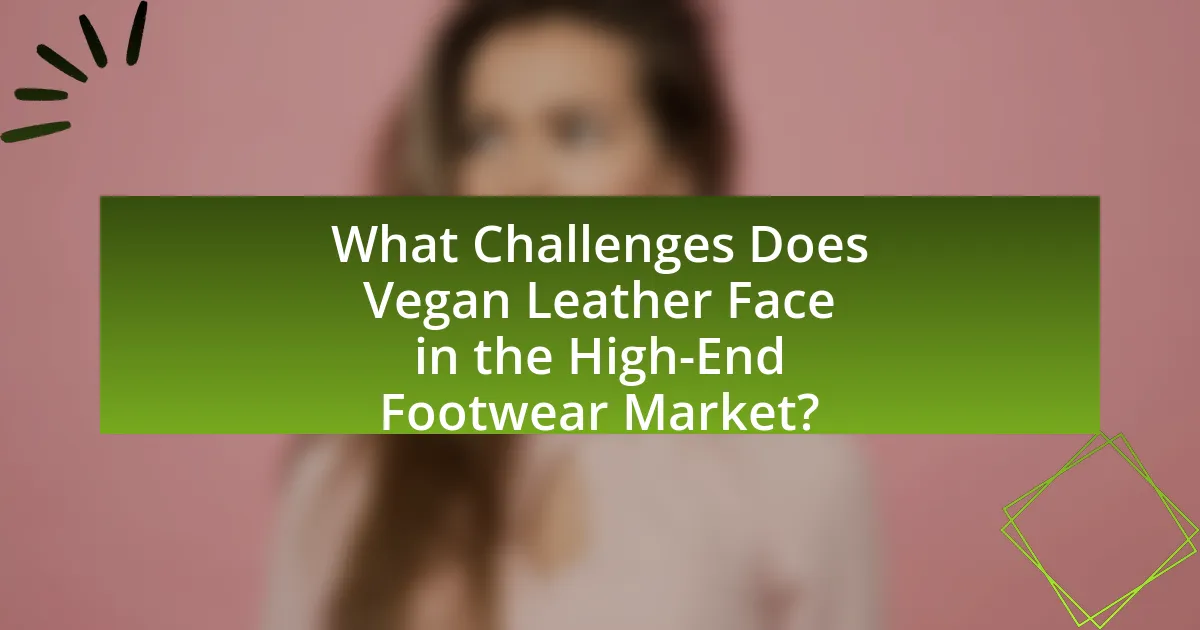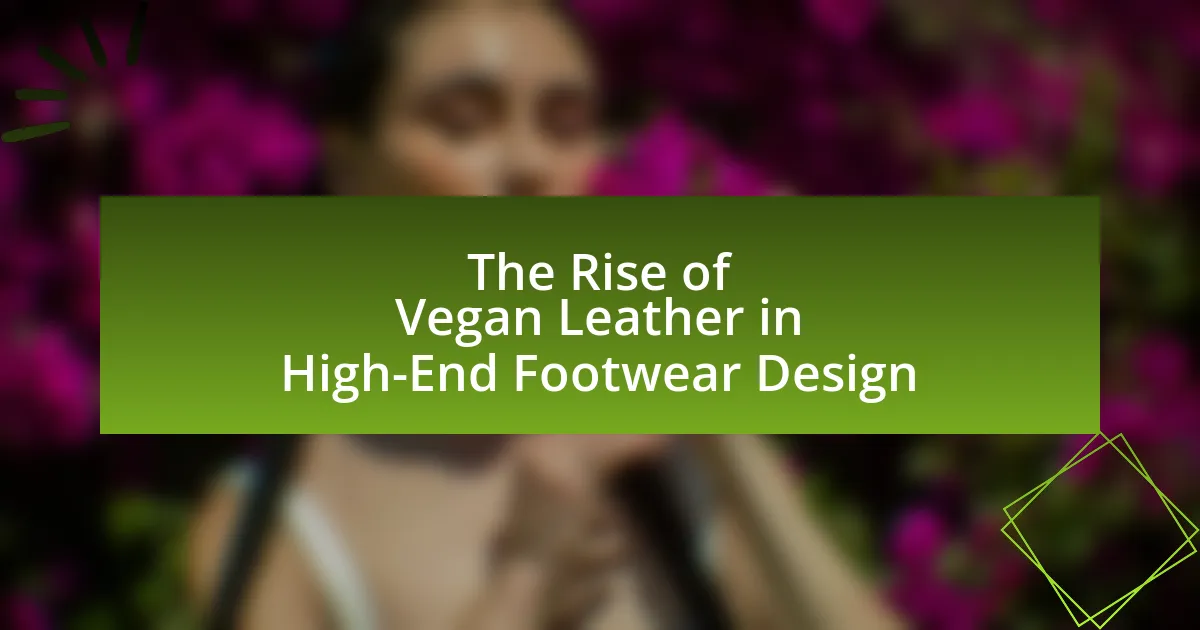Vegan leather, a synthetic alternative to traditional leather made from materials such as polyurethane and natural fibers, is increasingly popular in high-end footwear design due to rising consumer demand for sustainable and cruelty-free products. This article explores the differences between vegan and traditional leather, the materials used in vegan leather production, and the ethical and environmental considerations driving its adoption by designers. It also addresses misconceptions about vegan leather, its cost compared to traditional leather, and future trends in the market, highlighting innovations that enhance its quality and sustainability. The discussion emphasizes the importance of educating consumers and implementing effective marketing strategies to promote vegan leather footwear.

What is Vegan Leather and Why is it Gaining Popularity in High-End Footwear Design?
Vegan leather is a synthetic alternative to traditional leather made from animal hides, often produced from materials like polyurethane or natural fibers such as cork and pineapple leaves. Its popularity in high-end footwear design is increasing due to growing consumer demand for sustainable and cruelty-free products, with a 2021 report indicating that the global vegan leather market is projected to reach $89.6 billion by 2025. This shift is driven by ethical considerations, environmental concerns, and advancements in technology that enhance the quality and aesthetics of vegan leather, making it a viable option for luxury brands.
How is Vegan Leather Different from Traditional Leather?
Vegan leather is different from traditional leather primarily in its material composition; vegan leather is made from synthetic or plant-based materials, while traditional leather is derived from animal hides. The production of vegan leather often utilizes polyurethane or polyvinyl chloride, which can be more environmentally friendly depending on the manufacturing process, whereas traditional leather production involves tanning processes that can be harmful to the environment. Additionally, vegan leather does not involve animal cruelty, making it a preferred choice for ethical consumers.
What materials are commonly used to create Vegan Leather?
Vegan leather is commonly created using materials such as polyurethane (PU), polyvinyl chloride (PVC), and natural fibers like cork, pineapple leaves (Piñatex), and apple peels. Polyurethane is a popular synthetic alternative that mimics the texture and appearance of traditional leather while being more environmentally friendly than PVC. Natural fibers, such as cork and Piñatex, are derived from renewable resources, offering sustainable options for vegan leather production. These materials provide a range of textures and durability, making them suitable for high-end footwear design.
How does the production process of Vegan Leather compare to that of traditional leather?
The production process of vegan leather differs significantly from that of traditional leather. Vegan leather is typically made from synthetic materials such as polyurethane or natural materials like cork and pineapple leaves, which require less water and no animal products, whereas traditional leather is produced through the tanning of animal hides, a process that often involves harmful chemicals and significant water usage. For instance, the tanning process for traditional leather can consume up to 15,000 liters of water per ton of hide, while vegan leather production can be more sustainable, depending on the materials used. This distinction highlights the environmental impact of each production method, with vegan leather generally offering a more eco-friendly alternative.
Why are Designers Choosing Vegan Leather for High-End Footwear?
Designers are choosing vegan leather for high-end footwear primarily due to its sustainability and ethical considerations. Vegan leather, often made from materials like polyurethane or recycled plastics, significantly reduces the environmental impact associated with traditional leather production, which involves resource-intensive processes and animal cruelty. According to a 2021 report by the Fashion Institute of Technology, the demand for sustainable fashion options has surged, with 66% of consumers willing to pay more for brands that are environmentally friendly. This shift in consumer preference drives designers to adopt vegan leather, aligning their products with market trends and ethical values.
What ethical considerations are influencing the shift towards Vegan Leather?
The ethical considerations influencing the shift towards Vegan Leather include animal welfare, environmental sustainability, and labor practices. Animal welfare concerns arise from the cruelty associated with traditional leather production, prompting consumers to seek alternatives that do not involve animal exploitation. Environmental sustainability is a significant factor, as traditional leather tanning processes often involve toxic chemicals and contribute to pollution; Vegan Leather, particularly those made from plant-based materials, presents a more eco-friendly option. Additionally, ethical labor practices are increasingly important, with consumers favoring materials produced under fair working conditions, which some Vegan Leather manufacturers prioritize. These considerations collectively drive the demand for Vegan Leather in high-end footwear design, reflecting a broader societal shift towards more responsible consumption.
How does Vegan Leather align with sustainability trends in fashion?
Vegan leather aligns with sustainability trends in fashion by offering an alternative to traditional animal leather that reduces environmental impact. Unlike conventional leather production, which involves resource-intensive processes and contributes to deforestation and greenhouse gas emissions, vegan leather can be made from sustainable materials such as pineapple leaves, apple peels, or recycled plastics. For instance, a study by the Fashion Institute of Technology found that plant-based leathers can significantly lower carbon footprints compared to animal-derived options. This shift towards vegan leather reflects a growing consumer demand for eco-friendly products, as evidenced by a 2021 survey indicating that 66% of global consumers are willing to pay more for sustainable brands.
What are the Key Benefits of Using Vegan Leather in Footwear Design?
The key benefits of using vegan leather in footwear design include sustainability, animal welfare, and versatility. Vegan leather is often made from eco-friendly materials such as polyurethane or recycled plastics, reducing the environmental impact compared to traditional leather production, which involves resource-intensive processes and harmful chemicals. Additionally, using vegan leather eliminates the ethical concerns associated with animal cruelty, appealing to a growing consumer base that prioritizes humane practices. Furthermore, vegan leather offers a wide range of textures and styles, allowing designers to create innovative and fashionable footwear options that cater to diverse tastes.
How does Vegan Leather impact the overall quality and durability of footwear?
Vegan leather significantly enhances the overall quality and durability of footwear by providing a sustainable alternative to traditional leather without compromising performance. Unlike animal leather, which can be prone to cracking and wear over time, many vegan leather options are designed to be water-resistant and more resilient to environmental factors. For instance, polyurethane (PU) and thermoplastic polyurethane (TPU) are commonly used materials that offer high durability and flexibility, making them suitable for various footwear applications. Studies indicate that vegan leather can withstand similar levels of abrasion and stress as conventional leather, ensuring longevity in footwear products.
What aesthetic advantages does Vegan Leather offer to high-end footwear designers?
Vegan leather offers high-end footwear designers a range of aesthetic advantages, including versatility in texture and color, as well as the ability to mimic traditional leather’s luxurious appearance. This material can be produced in various finishes, such as matte, glossy, or textured, allowing designers to create unique and innovative styles that appeal to diverse consumer preferences. Additionally, vegan leather can be dyed in a wider array of colors compared to animal leather, enabling more creative freedom in design. The use of vegan leather also aligns with contemporary consumer values, enhancing the overall appeal of footwear collections by promoting sustainability without compromising on style.

What Challenges Does Vegan Leather Face in the High-End Footwear Market?
Vegan leather faces significant challenges in the high-end footwear market primarily due to perceptions of quality and durability. Many consumers associate luxury footwear with traditional materials like genuine leather, which are often perceived as more durable and high-quality. This perception can hinder the acceptance of vegan leather, despite advancements in technology that have improved its quality. Additionally, the high-end market often demands exclusivity and craftsmanship, which can be difficult for vegan leather brands to convey, as they may lack the heritage and artisanal reputation that established leather brands possess. Furthermore, sourcing sustainable and high-quality vegan materials can be costly, impacting pricing strategies and market competitiveness.
What are the common misconceptions about Vegan Leather?
Common misconceptions about vegan leather include the belief that it is entirely eco-friendly, that it lacks durability compared to genuine leather, and that it is always made from plant-based materials. While some vegan leathers are made from sustainable sources, many are produced using synthetic materials like polyurethane or PVC, which can have significant environmental impacts due to their production processes. Additionally, vegan leather can be quite durable, often matching or exceeding the lifespan of traditional leather, depending on the quality of the materials used. Lastly, not all vegan leather is plant-based; some are derived from petroleum-based products, which contradicts the assumption that all vegan options are inherently sustainable.
How do these misconceptions affect consumer perceptions of Vegan Leather footwear?
Misconceptions about vegan leather significantly impact consumer perceptions of vegan leather footwear by fostering skepticism regarding its quality and durability. Many consumers mistakenly believe that vegan leather is inferior to traditional leather, leading to doubts about its longevity and performance. This perception is reinforced by the association of vegan leather with lower-priced, mass-produced items, which can diminish its appeal in the high-end market. Furthermore, misconceptions about the environmental impact of vegan leather, such as the belief that all synthetic materials are harmful, can deter eco-conscious consumers. Research indicates that 66% of consumers are willing to pay more for sustainable products, but negative perceptions can hinder their willingness to invest in vegan leather options. Thus, addressing these misconceptions is crucial for enhancing consumer trust and acceptance of vegan leather footwear in the luxury segment.
What steps can brands take to educate consumers about Vegan Leather?
Brands can educate consumers about Vegan Leather by implementing targeted awareness campaigns. These campaigns can include informative content on social media platforms, highlighting the environmental benefits and ethical considerations of Vegan Leather compared to traditional leather. For instance, brands can share statistics indicating that the production of Vegan Leather often results in lower carbon emissions and reduced water usage, which appeals to eco-conscious consumers. Additionally, hosting workshops or webinars can provide consumers with firsthand knowledge about the materials and processes involved in creating Vegan Leather products. Collaborating with influencers who advocate for sustainable fashion can further amplify the message, reaching a broader audience and enhancing credibility.
How does the cost of Vegan Leather compare to traditional leather?
Vegan leather generally costs less than traditional leather. The price difference arises from the production processes; vegan leather is often made from synthetic materials like polyurethane or natural materials like cork, which can be cheaper to source and manufacture compared to animal hides. For instance, traditional leather can range from $20 to $100 per square foot, while vegan leather typically ranges from $10 to $50 per square foot, depending on the quality and brand. This cost-effectiveness makes vegan leather an attractive option for high-end footwear designers looking to balance quality and sustainability.
What factors contribute to the pricing of Vegan Leather in high-end footwear?
The pricing of vegan leather in high-end footwear is influenced by material quality, production processes, brand positioning, and sustainability practices. High-quality vegan leathers, such as those made from plant-based materials or innovative synthetics, often command higher prices due to their durability and aesthetic appeal. The production processes, which may involve advanced technology and ethical labor practices, also contribute to increased costs. Additionally, brands that position themselves as luxury or sustainable often price their products higher to reflect their market identity and commitment to ethical practices. For instance, brands like Stella McCartney utilize eco-friendly materials and transparent supply chains, which can elevate the price point of their vegan leather footwear.
How can brands balance cost and quality when using Vegan Leather?
Brands can balance cost and quality when using vegan leather by selecting high-quality materials that offer durability while also being cost-effective. For instance, brands can source innovative alternatives like polyurethane or plant-based leathers, which provide a balance between affordability and performance. Research indicates that the global vegan leather market is projected to reach $89.6 billion by 2025, highlighting the increasing availability and competition among suppliers, which can drive down costs while maintaining quality standards. Additionally, brands can invest in sustainable production processes that reduce waste and improve efficiency, ultimately lowering costs without compromising the quality of the final product.

What Future Trends Can We Expect for Vegan Leather in High-End Footwear Design?
Future trends for vegan leather in high-end footwear design include increased adoption of innovative materials, enhanced sustainability practices, and a focus on luxury aesthetics. As consumer demand for eco-friendly products rises, brands are likely to explore advanced alternatives such as mycelium leather and plant-based synthetics, which offer both durability and a reduced environmental footprint. Additionally, high-end brands are expected to prioritize transparency in sourcing and production processes, aligning with the growing consumer preference for ethical fashion. The global vegan leather market is projected to reach $89.6 billion by 2025, indicating a significant shift towards these materials in luxury footwear.
How is technology influencing the development of Vegan Leather?
Technology is significantly influencing the development of vegan leather by enabling the creation of innovative materials that mimic the properties of traditional leather. Advances in biotechnology, such as the use of mycelium from mushrooms and plant-based polymers, have led to the production of sustainable alternatives that are both durable and environmentally friendly. For instance, companies like MycoWorks and Bolt Threads utilize these technologies to produce vegan leather that not only reduces reliance on animal products but also minimizes environmental impact, as these materials can be produced with lower carbon footprints compared to conventional leather manufacturing processes.
What innovations are emerging in the production of Vegan Leather?
Innovations in the production of vegan leather include the development of materials derived from pineapple leaves, apple peels, and mushrooms. These bio-based alternatives not only reduce reliance on petroleum-based plastics but also offer unique textures and durability. For instance, Piñatex, made from pineapple leaf fibers, has gained traction for its sustainability and aesthetic appeal, while Mylo, derived from mycelium, provides a leather-like quality with a lower environmental impact. These advancements reflect a growing trend towards eco-friendly materials in high-end footwear design, aligning with consumer demand for sustainable fashion.
How might these innovations change the landscape of high-end footwear design?
Innovations in vegan leather are poised to significantly transform high-end footwear design by offering sustainable alternatives that do not compromise on luxury or aesthetics. The adoption of advanced materials, such as plant-based leathers and recycled synthetics, allows designers to create high-quality products that appeal to environmentally conscious consumers. For instance, brands like Stella McCartney have successfully integrated vegan leather into their collections, demonstrating that sustainability can coexist with high fashion. This shift not only caters to a growing market demand for ethical products but also encourages traditional luxury brands to rethink their material sourcing and production processes, ultimately reshaping industry standards.
What are some best practices for incorporating Vegan Leather into footwear collections?
To effectively incorporate Vegan Leather into footwear collections, brands should prioritize sourcing high-quality materials that mimic the look and feel of traditional leather while ensuring sustainability. This involves selecting vegan leathers made from eco-friendly materials such as pineapple leaves, apple peels, or recycled plastics, which not only reduce environmental impact but also appeal to conscious consumers. Additionally, brands should focus on innovative design techniques that highlight the unique properties of vegan leather, such as its versatility and durability, to create stylish and functional footwear. Collaborating with suppliers who specialize in vegan materials can enhance product quality and authenticity, while transparent marketing strategies that educate consumers about the benefits of vegan leather can foster brand loyalty.
How can designers ensure the quality and sustainability of their Vegan Leather products?
Designers can ensure the quality and sustainability of their vegan leather products by selecting high-quality, eco-friendly materials and employing responsible manufacturing processes. For instance, using plant-based alternatives like pineapple leather or apple leather not only reduces reliance on petroleum-based plastics but also minimizes environmental impact. Additionally, designers should prioritize certifications such as Global Organic Textile Standard (GOTS) or OEKO-TEX, which verify sustainable practices and material quality. Research indicates that the vegan leather market is projected to grow significantly, with a focus on sustainable practices driving consumer preference, thus reinforcing the importance of quality and sustainability in product design.
What marketing strategies can effectively promote Vegan Leather footwear to consumers?
Effective marketing strategies to promote Vegan Leather footwear include leveraging social media influencers, emphasizing sustainability, and utilizing targeted digital advertising. Social media influencers can showcase the product’s style and eco-friendliness, reaching a broader audience; for instance, 49% of consumers rely on influencer recommendations for purchase decisions. Highlighting the sustainability aspect appeals to the growing market of environmentally conscious consumers, as 66% of global consumers are willing to pay more for sustainable brands. Targeted digital advertising can effectively reach specific demographics interested in vegan and eco-friendly products, increasing conversion rates. These strategies collectively enhance brand visibility and consumer engagement in the competitive footwear market.



